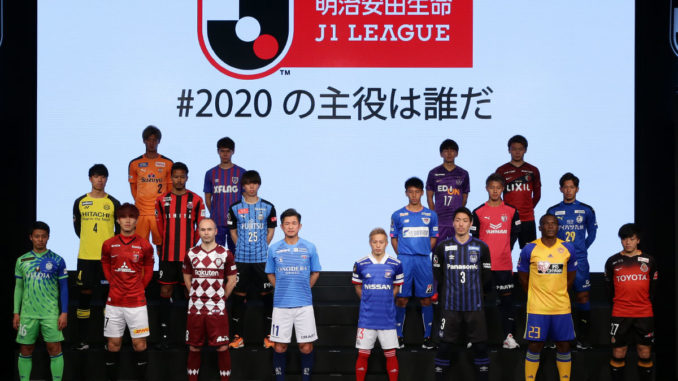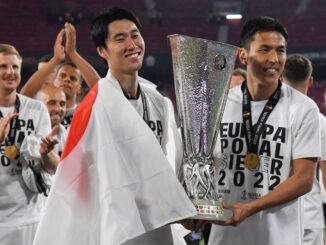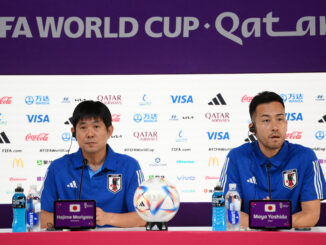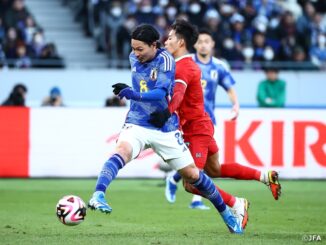
A new decade, new technology, three coaching changes, former champions returning and plenty of young talent to keep fans excited – the return of the J.League is finally here.
The 28th season of top-flight, professional, football in Japan gets underway this weekend as Urawa Reds visit Shonan Bellmare in the opening match and we’ve got you ready for kickoff with a look at how things might shake out in 2020.
KEY OFF-SEASON TALKING POINTS
* The arrival of VAR: Japan has been fairly late in adopting video technology into the league but after a trial in the Levain Cup last season the fully-fledged arrival of VAR will be an extra element to watch. There have been plenty of high-profile gaffes in recent years and the hope is that they will be removed whilst not stopping the flow of the game greatly.
* Pressure on the new coaches: It’s been a disappointing start for new Kashima boss Zago, having been eliminated from the ACL and then having lost their opening Levain Cup fixture with a squad that features plenty of turnover and he will be in the spotlight early in the new season. That will be the same for new S-Pulse coach Peter Cklamovski who is set to usher in a completely new approach in Shizuoka, while Takashi Kiyama will have a huge task in trying to ensure that Vegalta Sendai stay up.
* Pressure on the old coaches: There have been plenty of whispers that Urawa coach Otsuki is far from safe in his role after boardroom changes at Reds and along with Kim Myung-hwi and Bin Ukishima he’s high on the list of potential coaches to lose their jobs early on should those clubs start slowly.
* The impact of the Olympics: As was the case for the Rugby World Cup last year, several teams will again be inconvenienced by another major sporting event with Tokyo hosting the Olympic Games this year. FC Tokyo have a run of eight straight away matches in the middle of the year, Kashima have five in a row and Urawa are only at home in two of eight matches during the summer – that’s a clear issue for those possible title contenders along with the six-week break for the Games that will impact all clubs across all three divisions.
THE TITLE CONTENDERS – Yokohama F.Marinos, Kawasaki Frontale, Urawa Red Diamonds, Kashiwa Reysol
After having not only won the league last season but having done so by playing in a style that revolutionised Japanese football, Yokohama F.Marinos will rightly enter 2020 as the title favourites.
With greater squad depth following some solid off-season signings and only the one major departure, with on-loan winger Mateus returning to Nagoya, the champions will be very hard to beat.
With the club also setting the ACL alight early on and boss Ange Postecoglou having rightly been hailed as one of the world’s leading coaches, if a major European club asks for his services in the middle of the year then that could be perhaps the only issue that could see the club struggle.
The one team that is likely to challenge them is Kawasaki, who have admitted that they are looking to replicate Yokohama’s up-tempo, high and hard pressing brand of attacking football in an adjusted 4-3-3 formation. That suits the players they have better and with Leandro Damiao finally set to be handed a chance as the lone forward they are a side that could score freely.
Urawa have made the best signing of the off-season in the prolific 22-year-old Brazilian forward Leonardo, who could not only be a breakout star following his arrival from J2 side Albirex Niigata but could also be fast-tracked into the Japanese national team if he acquires citizenship.
With a new-look 4-4-2 that also seems better suited to the available talent it could be a season of great improvement at Reds with some veteran players struggling to hold their starting spots and young talent, such as midfielders Kai Shibato and Koya Yuriki, given a chance to shine whilst leftback Ryosuke Yamanaka should show that he is the best player in that role in the league.
The biggest surprise though could be the return of Kashiwa Reysol, a team that went from J2 promotion side to J1 winners back in 2011 and who could well push to repeat that remarkable feat.
Forwards Michael Olunga and Cristiano are amongst the best in the league and with solid options in midfield and defence and two of the J.League’s best goalkeepers on their books there’s no reason why Reysol can’t finish in the top four – at worst.
THE OUTSIDERS – Gamba Osaka, Vissel Kobe, Kashima Antlers
With as many as half a dozen new players set to start at Kashima this could well be a season of transition under a coach that’s new to Japanese football and whilst no ACL distractions is a positive, if pre-season is an indication they might not click until later in the year.
Gamba are renowned for making slow starts and if that continues then coach Tsuneyasu Miyamoto could find himself under real pressure, especially given the talent that he has at his disposal.
The arrival of Gen Shoji gives Gamba arguably the best defence in the league whilst Takashi Usami could finally be set to have the kind of impact that fans hoped he would on his return to Japan last year, so all the ingredients are there for success – if the coach can get the team to play consistently at a high standard.
Vissel Kobe are the real wildcard in this group with a squad stacked with quality yet one that’s also been inconsistent and has to deal with the demands of what could be a long ACL campaign as well as a packed schedule that will see star midfielder Iniesta and other key players sure to be rotated regularly.
MIDDLE OF THE ROAD – Cerezo Osaka, FC Tokyo, Sanfreece Hiroshima, Nagoya Grampus, Consadole Sapporo, Shimizu S-Pulse
With the league moving towards an era where teams are setting out to attack and dominate games rather than react and counter there’s a risk that the more conservative teams could struggle to keep pace with those more adventurous ones.
Included in that group of defensive-minded teams are Tokyo, Cerezo, Hiroshima and Nagoya and whilst it’s possible one of that quartet finds the consistency to push for a top four finish, it’s unlikely that they’ll have the goals in them to challenge the likes of F.Marinos and Frontale.
Two teams that will play far more expansively are Sapporo and Shimizu, with the former capable of being big movers from last season although a very minimal amount of off-season transfer activity could see the team struggle for depth if injuries strike.
S-Pulse will be a real team to watch under the guidance of Yokohama boss Postecoglou’s long-time assistant coach Cklamosvki.
They’re sure to struggle for the first half of the season as the players adapt to what will be a vastly different style of football under the Australian coach, but over the second half of the year they should see dramatic improvement and they’ll be a likely title contender in 2021 if Cklamovski is given the time to fully implement his unique brand of football.
THE STRUGGLERS – Oita Trinita, Yokohama FC, Vegalta Sendai, Shonan Bellmare, Sagan Tosu
One of last season’s best stories was the excellent return to J1 of an Oita side that played positively whether home or away and given the coach, Tomohiro Katanosaka, remains they’ll have enough to stay up but could likely find themselves struggling for periods given a lack of real star quality right across the pitch, although in keeper Shun Takagi and defender Tomoki Iwata they have some of the league’s more under-rated talents.
The second promoted club, Yokohama FC, are back in J1 for just the second time in their history and I might stand alone as thinking they’ll have enough to survive.
It’s a highly curious mix of senior citizens – led by soon-to-be 53-year-old Kazuyoshi Miura – and teenage stars but they have a fine coach in Takahiro Shimotaira and some real quality in midfield – the likes of young talents Kosuke Saito, Katsuhiro Nakayama and Yusuke Matsuo – and that should see them do just enough to stay up.
The teams really likely to struggle are headed by a Sendai side under a coach unproven at J1 level and who have been struck down by injuries to key off-season signings in winger Isaac Cuenca and forward Alexandre Guedes that will see them really struggle to make a positive start.
Shonan have some fine young central midfielders with Mitsuki Saito and Daiki Kaneko both superb talents who could find their way into Japan’s Olympic team but with only one foreign player on their books and modest talent elsewhere they could also battle to survive.
That leaves Tosu who are most people’s picks for automatic relegation having lost some major financial backers and a host of regulars from last season and have no major quality being brought in to replace them.
CLUB-BY-CLUB
CONSADOLE SAPPORO
KEY PLAYER: Chanathip Songkrasin
YOUNG PLAYER TO WATCH: Tomoki Takamine
VEGALTA SENDAI
KEY PLAYER: Simao Mate
YOUNG PLAYER TO WATCH: Wataru Tanaka
KASHIMA ANTLERS
KEY PLAYER: Kento Misao
YOUNG PLAYER TO WATCH: Ryotaro Araki
URAWA REDS
KEY PLAYER: Leonardo
YOUNG PLAYER TO WATCH: Daiki Hashioka
KASHIWA REYSOL
KEY PLAYER: Cristiano
YOUNG PLAYER TO WATCH: Taiyo Koga
FC TOKYO
KEY PLAYER: Diego Oliveira
YOUNG PLAYER TO WATCH: Kazuya Konno
KAWASAKI FRONTALE
KEY PLAYER: Leandro Damiao
YOUNG PLAYER TO WATCH: Ao Tanaka
YOKOHAMA F.MARINOS
KEY PLAYER: Marcos Junior
YOUNG PLAYER TO WATCH: Keita Endo
YOKOHAMA FC
KEY PLAYER: Yuji Rokutan
YOUNG PLAYER TO WATCH: Yuki Kobayashi
SHONAN BELLMARE
KEY PLAYER: Tarik Elyounoussi
YOUNG PLAYER TO WATCH: Mitsuki Saito
SHIMIZU S-PULSE
KEY PLAYER: Neto
YOUNG PLAYER TO WATCH: Makoto Okazaki
NAGOYA GRAMPUS
KEY PLAYER: Mitch Langerak
YOUNG PLAYER TO WATCH: Yuki Soma
GAMBA OSAKA
KEY PLAYER: Takashi Usami
YOUNG PLAYER TO WATCH: Yuya Fukuda
CEREZO OSAKA
KEY PLAYER: Hiroshi Kiyotake
YOUNG PLAYER TO WATCH: Jun Nishikawa
VISSEL KOBE
KEY PLAYER: Andres Iniesta
YOUNG PLAYER TO WATCH: Ryuho Kikuchi
SANFRECCE HIROSHIMA
KEY PLAYER: Yoshifumi Kashiwa
YOUNG PLAYER TO WATCH: Tsukasa Morishima
SAGAN TOSU
KEY PLAYER: Mu Kanazaki
YOUNG PLAYER TO WATCH: Daiki Matsuoka
OITA TRINITA
KEY PLAYER: Shun Takagi
YOUNG PLAYER TO WATCH: Tomoki Iwata
Photo: J.League
Listen to Episode 49 of The Asian Game podcast on which we talk to Yokohama F.Marinos coach Ange Postecoglou and Shimizu S-Pulse coach Peter Cklamovski




